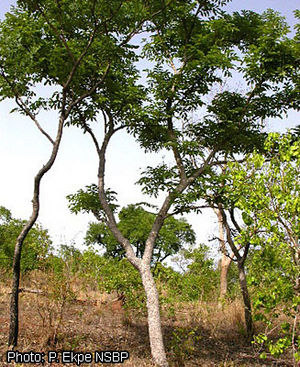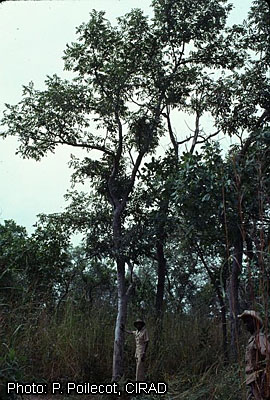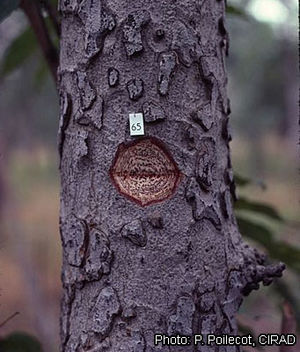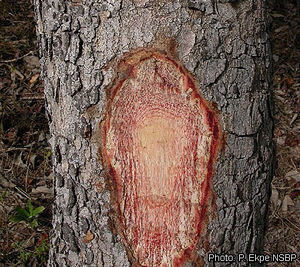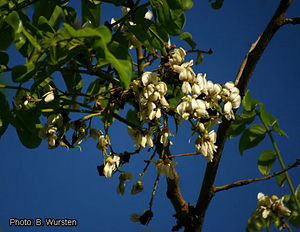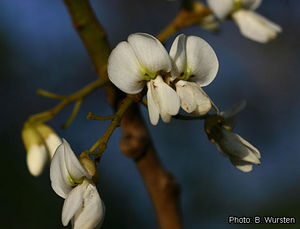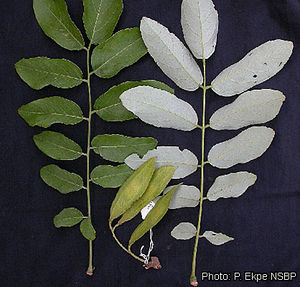Xeroderris stuhlmannii (PROTA)
Introduction |
| General importance | |
| Geographic coverage Africa | |
| Geographic coverage World | |
| Cereal / pulse | |
| Dye / tannin | |
| Medicinal | |
| Timber | |
| Fuel | |
| Ornamental | |
| Forage / feed | |
| Auxiliary plant | |
| Fibre | |
| Food security | |
Xeroderris stuhlmannii (Taub.) Mendonça & E.C.Sousa
- Protologue: Bol. Soc. Brot., ser. 2, 43: 273 (1968).
- Family: Papilionaceae (Leguminosae - Papilionoideae, Fabaceae)
- Chromosome number: 2n = 24
Synonyms
- Ostryoderris stuhlmannii (Taub.) Harms (1915).
Vernacular names
- Wing pod, wing bean (En).
- Micala (Po).
- Mnyinga, mondogondo, mumundu (Sw).
Origin and geographic distribution
Xeroderris stuhlmannii is widespread in tropical Africa, from Senegal east to Kenya and south to Zimbabwe, Mozambique and northern South Africa.
Uses
The wood is used for furniture, railway sleepers, canoes, handles and utensils. In Tanzania the wood is locally used to make grain mortars. In Ghana the branches are used for making roofs. The wood is suitable for heavy construction, flooring, vehicle bodies, sporting goods, interior trim, joinery, poles and piles, carving, toys and novelties, turnery, veneer and plywood. It is also used as firewood and for the production of charcoal.
The bark contains a fibre, which is sometimes used to make brooms. In Zambia the bark is used for tanning hides. The red bark exudate is sometimes used as a dye and for tanning. Seeds are eaten in times of food shortage after prolonged cooking, as they are reported to be poisonous in fresh condition. They are also ground to produce a meal. In Tanzania Xeroderris stuhlmannii is considered useful for wind breaks. Leaves and fruits are browsed by livestock.
The bark is used in traditional medicine to treat coughs, colds, rheumatic arthritis, stomach-ache, dysentery, eye infections, wounds, and as a purgative. Root decoctions serve as a vermifuge; they are taken to treat elephantiasis, gonorrhoea, syphilis, dysmenorrhoea, chest pains and urinary complaints, and applied externally against ringworm. Pounded roots are applied to sores. The leaves are used to treat colds, coughs, wounds, stomach problems, amenorrhoea, fever and malaria.
Properties
The heartwood is cream-coloured to dark yellow, occasionally with reddish streaks, and not distinctly demarcated from the sapwood. The grain is straight, rarely interlocked, texture moderately fine and even.
The wood is heavy, with a density of 800–835 kg/m³ at 12% moisture content, and fairly hard. It air dries slowly, with considerable distortion but little checking; kiln drying gives best results. Shrinkage rates from green to 12% moisture content are 3.1% radial and 4.5% tangential. Once dry, the wood can be unstable in service. The surface of the wood can be given a smooth, lustrous finish. The nailing, screwing and gluing properties are good. The wood is moderately durable; it is susceptible to powder-post beetle attack, but not particularly to termite and pinhole borer attack. The wood is moderately resistant to impregnation.
The ultimate fibres are 1.5–1.6 mm long and 20–23 μm wide, with a lumen diameter of 5 μm and a cell wall thickness of about 8 μm. Due to the narrow lumen and thick walls, the fibres are rigid and the wood is not suitable for the production of good quality paper.
Root decoctions have reportedly violent action on the intestines, causing strong emesis and may cause loss of sight.
Description
- Small to medium-sized tree up to 18(–27) m tall; bole branchless for up to 12 m, straight and cylindrical, up to 120 cm in diameter; bark usually rough, flaking, grey-brown, with a red exudate; crown rounded, with ascending branches; young twigs brownish hairy, older branches thickened, corky, with distinct leaf scars.
- Leaves alternate and often clustered near the branch tips, imparipinnately compound with (5–)6–8 pairs of leaflets; stipules linear-lanceolate, 6–12 mm long, caducous; leaflets more or less opposite, oblong-lanceolate to oblong-ovate, 4–13 cm × 2.5–6.5(–9) cm, asymmetrically rounded or cordate at base, usually rounded at apex, margins slightly recurved, leathery, golden or silvery silky hairy when young, later glabrescent.
- Inflorescence an axillary panicle 7–18(–22) cm long, crowded at the ends of twigs, with spreading branches, rusty hairy, many-flowered.
- Flowers bisexual, papilionaceous; pedicel 2–5 mm long; calyx broadly campanulate, 4–5 mm long, hairy; corolla c. 1.5 cm long, white or greenish white, standard circular to oblate, with short claw, wings and keel about equally long; stamens 10, 9 fused and 1 free; ovary superior, sessile, 1-celled, style curved, stigma small.
- Fruit a linear-oblong pod 9–18(–30) cm × 2–5 cm, flattened, with a wing at both sides, pale brown, reticulately veined, indehiscent, 1–3(–5)-seeded.
- Seeds kidney-shaped, c. 12 mm long, smooth, red-brown.
Other botanical information
The tree often flowers at the end of the dry season, shortly before new leaves develop. The fruits are sometimes malformed and berry-like, which is caused by galls. Nodulation and nitrogenase activity have been recorded for the roots, indicating atmospheric nitrogen fixation.
Xeroderris comprises a single species. It is related to Aganope.
Ecology
Xeroderris stuhlmannii occurs in deciduous woodland and bushland up to 1650 m altitude. It grows particularly on well-drained soils, also on poor sandy soils, and is drought resistant.
Management
Xeroderris stuhlmannii can be propagated by seeds and suckers. There are 3500–5000 seeds per kg. The germination rate is up to 70% 2 weeks after sowing. The tree tolerates pruning, pollarding and coppicing.
Genetic resources
Xeroderris stuhlmannii is widespread and locally common, especially in East and southern Africa, and not under threat of genetic erosion.
Prospects
Xeroderris stuhlmannii is a multipurpose tree that deserves more research attention. Although it is widely used in traditional medicine, very little is known about its phytochemistry and pharmacological properties. Detailed information is needed on natural regeneration and growth rates to recommend appropriate methods of sustainable harvesting. This is needed because the most commonly harvested parts, apart from the timber, are bark and roots for medicinal purposes, and harvesting these may also kill the tree.
Major references
- Arbonnier, M., 2000. Arbres, arbustes et lianes des zones sèches d’Afrique de l’Ouest. CIRAD, MNHN, UICN. 541 pp.
- Bolza, E. & Keating, W.G., 1972. African timbers: the properties, uses and characteristics of 700 species. Division of Building Research, CSIRO, Melbourne, Australia. 710 pp.
- Burkill, H.M., 1995. The useful plants of West Tropical Africa. 2nd Edition. Volume 3, Families J–L. Royal Botanic Gardens, Kew, Richmond, United Kingdom. 857 pp.
- Mbuya, L.P., Msanga, H.P., Ruffo, C.K., Birnie, A. & Tengnäs, B., 1994. Useful trees and shrubs for Tanzania: identification, propagation and management for agricultural and pastoral communities. Technical Handbook 6. Regional Soil Conservation Unit/SIDA, Nairobi, Kenya. 542 pp.
- Palmer, E. & Pitman, N., 1972–1974. Trees of southern Africa, covering all known indigenous species in the Republic of South Africa, South-West Africa, Botswana, Lesotho and Swaziland. 3 volumes. Balkema, Cape Town, South Africa. 2235 pp.
Other references
- Asase, A., Oteng-Yeboah, A.A., Odamtten, G.T. & Simmonds, M.S.J., 2005. Ethnobotanical study of some Ghanaian anti-malarial plants. Journal of Ethnopharmacology 99(2–3): 273–279.
- Bryce, J.M., 1967. The commercial timbers of Tanzania. Tanzania Forest Division, Utilisation Section, Moshi, Tanzania. 139 pp.
- Coates Palgrave, K., 1983. Trees of southern Africa. 2nd Edition. Struik Publishers, Cape Town, South Africa. 959 pp.
- Gelfand, M., Mavi, S., Drummond, R.B. & Ndemera, B., 1985. The traditional medical practitioner in Zimbabwe: his principles of practice and pharmacopoeia. Mambo Press, Gweru, Zimbabwe. 411 pp.
- Huxham, S.K., Schrire, B.D., Davis, S.D, & Prendergast, H.D.V., 1998. Dryland legumes in Africa: food for thought. Royal Botanic Gardens, Kew, Richmond, United Kingdom. 84 pp.
- Kokwaro, J.O., 1993. Medicinal plants of East Africa. 2nd Edition. Kenya Literature Bureau, Nairobi, Kenya. 401 pp.
- Neuwinger, H.D., 2000. African traditional medicine: a dictionary of plant use and applications. Medpharm Scientific, Stuttgart, Germany. 589 pp.
- Taïta, P., 2000. La biodiversité des espèces spontanées utilisées dans l’alimentation et la pharmacopée dans la région de la réserve de biosphère de la Mare aux Hippopotames. In: Actes du Forum National de la Recherche Scientifique et des Innovations Technologiques (FRSIT), 3–8 avril 2000, Ouagadougou, Burkina Faso. Tome 2. Sécurité alimentaire. pp. 77–95.
- Tropical Products Institute, undated. Pulping trials on ‘miombo’ woodland species from Tanganyika. Report L3. Tropical Products Institute, London, United Kingdom. 11 pp.
- van Wyk, B. & van Wyk, P., 1997. Field guide to trees of southern Africa. Struik Publishers, Cape Town, South Africa. 536 pp.
Author(s)
- R.H.M.J. Lemmens, PROTA Network Office Europe, Wageningen University, P.O. Box 341, 6700 AH Wageningen, Netherlands
Correct citation of this article
Lemmens, R.H.M.J., 2007. Xeroderris stuhlmannii (Taub.) Mendonça & E.C.Sousa. In: Louppe, D., Oteng-Amoako, A.A. & Brink, M. (Editors). PROTA (Plant Resources of Tropical Africa / Ressources végétales de l’Afrique tropicale), Wageningen, Netherlands. Accessed 18 December 2024.
- See the Prota4U database.

